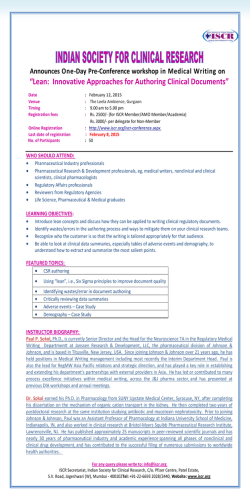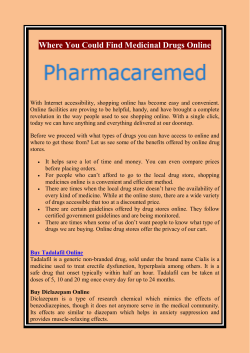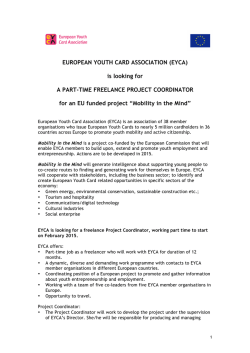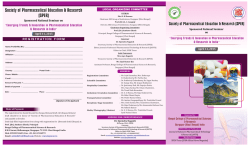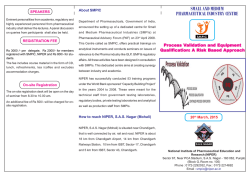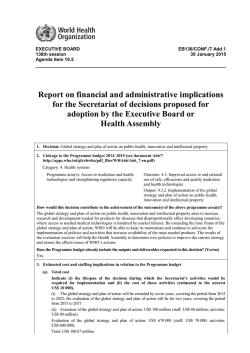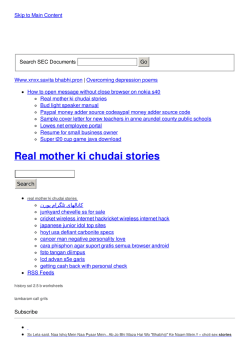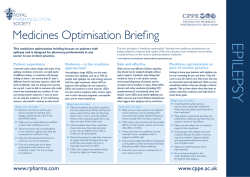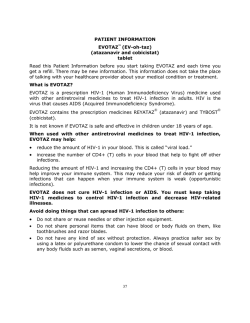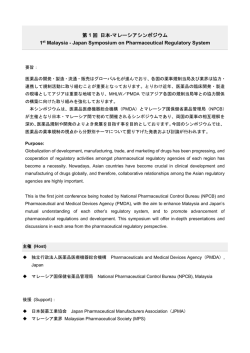
Acción Internacional para la Salud
Patients’ groups and industry funding Unhealthy Influence Health policy-makers at the national and European level recognise the benefits of listening to the public and shaping policy in the light of the experiences of users of healthcare systems. But too often, listening to the public is reduced to listening to a small number of patients’ organisations, without questioning those groups’ claims to legitimacy, nor examining their sources of funding. Health Action International ( HAI ) Europe calls for a truly democratic approach to the development of medicines’ policy, one that is open to the views of all citizens, meets high standards of transparency and clearly exposes conflicts of interest. Defining patients and patients’ groups Almost every national or European health policy document accords a high importance to the need to listen to and ›empower‹ patients. Significantly, most references are to ›patients‹ and only occasionally to ›patients and the public‹ or ›patients and consumers‹. What policymakers seem to have in mind when they talk of ›patients‹ is quite specific – people suffering from a chronic illness, whose contacts with the healthcare system are frequent and often serious. Direct (as a patient) or indirect (as a patient’s relative) experience of a condition seems to be required for legitimate comment. Involvement in consultative processes is generally limited to, or dominated by, organisations articulating the concerns and needs of those with chronic illnesses. Other, more typical users of the healthcare system – the consumers of headache pills or contraception, who occasionally visit their family doctor – do not have so specific an advocate, nor one that can be labelled a ›patients’ group‹. The result is a narrowing of the terms of the debate around the assumptions that there is a permanent commonality of interest between patients’ groups and the pharmaceutical industry and that medicines are the primary path to good health. Outnumbered and falling outside the definition of a patients’ group, those voices calling for greater spending on primary health care and health promotion, rather than on new medicines to treat chronic disease, find governments less inclined to listen. Case study: The International Alliance of Patients’ Organisations ( IAPO) (i.e.) the chronically ill«. Founded and funded by the pharmaceutical industry, focused on chronic disease, the IAPO speaks for industry in calling on the World Health Organisation (WHO) to »clearly state that there should be a much higher budget for the innovation of new medicines« and in »particularly support[ing] the need for public/private partnerships in the innovation process. This will make it possible to bring together public money with the ability and capacity of industry to innovate and distribute medicines whilst, since industry’s investment will be much lower, it will be easier for them to obtain an adequate return on investment in addition to lowering prices« [IAPO comments on the WHO Priority Medicines for Europe and the World initiative, September 2004 ]. Present at every forum, the IAPO offers the pharmaceutical industry credibility by taking positions that are harder to refute when coming from a patients’ organisation than from a company. The IAPO was founded in 1999 with funding from Pharmaceutical Partners for Better Healthcare, a consortium of 40 ›innovative pharmaceutical companies‹, one of whom, Pfizer, proudly publicises its involvement on its own website: »[t]he Pfizer Foundation partnered with the National Health Council and a coalition of international patient groups to help create the International Alliance of Patients Organizations«. The IAPO website lists current or past ›Gold Industry Partners‹, contributing $50,000 p.a., as Medtronic Foundation, Johnson & Johnson, Merck, Novartis and Pfizer. The IAPO recognises confusions around the terminology of ›patient‹ and ›consumer‹ and makes clear its view that »patients’ organisations are the organisations of people with a long-term medical condition, What price industry funding? Patients’ groups exist on a continuum from those independent of funding from the pharmaceutical industry, through the reluctantly industry-funded to the enthusiastically industry-funded and ultimately the industry- founded. Most do valuable work in terms of advocacy and also in providing services and information. HAI Europe believes that the cost of accepting funds from the pharmaceutical industry – the real or perceived risk of being influenced to act in line with companies’ agenda – outweighs the benefit of the money received. For companies, in a context where direct-to-consumer-advertising of prescription-only medicines is illegal within the European Union, sales messages carry more authority with consumers when they are transmitted by patients’ groups and presented as a ›disease awareness campaign‹. As well as actions or statements that can be judged as being in favour of industry agenda, the extent to which patients’ groups are influenced by companies is also measured by cases where patients’ groups remain silent and do not criticise industry, even when this appears to be against the interests of the patients the groups claim to represent. Assessing the influence of the pharmaceutical industry on patients’ groups is made difficult by widespread failure to publish accounting data. Either figures are not released at all or they exist only for several years in arrears; when data are public, the use of general categories like ›grants received‹ or ›event sponsorship‹ obscures who actually gave how much. The failure to publish financial data gives an impression that a group has something to hide and is itself an implicit acknowledgement that receiving industry funding would lead to awkward questions about conflicts of interest. For those groups that enthusiastically embrace pharmaceutical industry support and who believe that they share a common interest with industry, this work is more or less compromised when they appear to be untroubled by evidence of harm from drugs and suppression of that evidence of harm. If the relationship that a group has with its corporate donors is not constantly scrutinised to check that it continues to be in the best interest of patients, then the group may be assumed to be acting in the interest of the industry first and of patients second. Government funding – equally likely to trigger conflicts of interest? HAI Europe has a policy of not accepting funds from the pharmaceutical industry and receives most of its income from European governments. The charge can be laid that HAI Europe – or any other recipient of government funding – consciously or unconsciously mutes its criticism of those governments from whom it receives funds. HAI Europe is confident that its positions towards governments have not been watered down in cases where it receives funds from those governments. As one example, HAI Europe very clearly and publicly criticised the Dutch government in relation to its Priority Medicines initiative. Groups receiving funding from the pharmaceutical industry may also feel able to demonstrate that they are not influenced to lend support to, or lessen criticism of, particular companies. A clearer distinction lies in the intent of the donor. Companies’ obligations are to maximise sales and hence returns for their shareholders; their relationship with patients’ organisations is driven by the intent to influence those organisations to act in line with the goal of maximising sales 1. This commercial goal often runs counter to public health goals. Governments have many, sometimes contradictory, obligations: to protect health, safeguard jobs, run a strong economy and so on. By not being beholden to any single agenda, governments leave space for debate, which makes their funding less compromising. 1 This intent is well-described as the desire to »convert such relationships [with patients’ groups] into important business tools to meet their corporate objectives«; [Harnessing patient power: strategies for speeding drug approval, building and retaining market share, Reuters Business Insight, January 2004] Is a certain proportion of industry funding acceptable? The idea of setting a threshold of industry funding, below which any influence that funding may have is considered ›acceptable‹ is deceptively appealing. But with many groups not publishing full financial data, it is hard to know exactly what proportion of their funds comes from industry. If and when it did become possible to know definitively what funding is received from which sources, setting a threshold would anyway be an over-simplification. It would put patients’ groups into two categories: those that are being influenced and those that are not; if all groups could get themsel- ves below the threshold, the influence companies are having is wished away. Rather, all industry funding should be treated with suspicion because the intent of companies in granting funds is always to influence groups to support their agenda. Emphasis should be put on strong safeguards to mitigate the impact of this influence – transparency of funding, balanced representation of non-industry-funded groups and sanctions against those failing to declare possible conflicts of interest. Is there any alternative to industry funding? For more reluctant recipients of industry funding, it is commonly claimed that there are few other sources of funding and that they can protect themselves from undue influence by refusing to endorse particular products and by applying codes of conduct for relations with industry. However, much industry funding goes to large patients’ groups which have ample other sources of funds and are therefore making a conscious choice to take industry funds, a choice that is not driven by a fear of insolvency. For organisations that can more plausibly claim that they are reliant on industry funds, it is better to look for means of continuing their work, subject to objective assessments of the value of that work, without such reliance on sources of funds which expose them to a conflict of interest. Recommendations • Policy-makers should not privilege certain categories of patients’ groups nor believe that consulting with such groups alone amounts to a full and democratic debate on health and medicines’ policy. • Policy-makers should proactively seek engagement from consumer groups and others with a broad constituency and responsibility to advocate balanced health policies, rather than lobbying for one particular issue or condition. • Minimum standards of transparency should be made a condition of involvement in national or European consultative exercises. These should include: · publication of accounts of one financial year within six months of the start of the next financial year; · published data to specify sums received from all institutional donors (companies, foundations, governments or European Union sources); · avoidance of the use of generic categories of income. Health Action International Europe Jacob van Lennepkade 334-T 1053 NJ Amsterdam, Netherlands Tel: +31 (0) 20 683 36 84 Fax: +31 (0) 20 685 50 02 [email protected] www.haiweb.org This policy paper is one in a series outlining HAI Europe’s position on key issues affecting European medicines’ policy. Together with its counterparts in Latin America, Africa and Asia-Pacific, HAI Europe campaigns for access to, and rational use of, medicines. • Policy-makers should open their eyes to the influence that industry funding has on patients’ groups and adopt a correspondingly sceptical attitude towards them. • The money that the pharmaceutical industry wants to provide to support patients’ groups should be placed in a single fund to which groups then apply. Decisions would be made by a panel composed of different stakeholders, based on the quality of the applications. The criteria for accepting applications could include a preference for groups whose other sources of funding are likely to be limited. Small groups, such as those working on rare diseases, would survive on the quality of their work. The direct link between a company and a patients’ organisation would be broken.
© Copyright 2025
